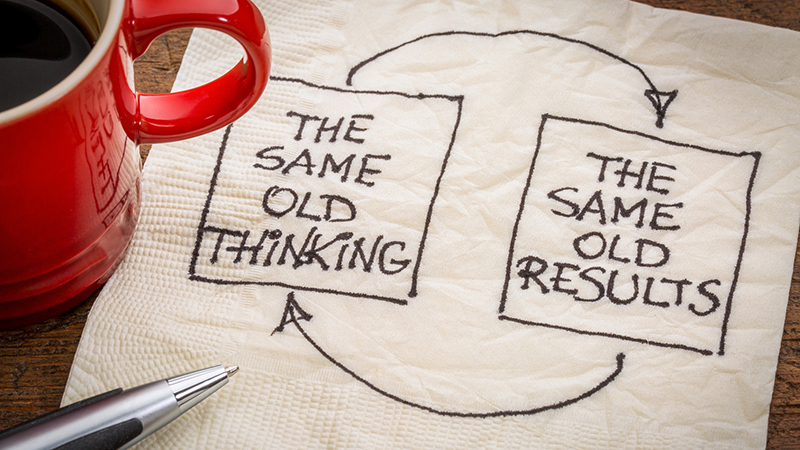
Negative patterns of thinking occur when you think about yourself and your situations in a harmful light. While everyone experiences negative thinking now and again, it can escalate if not managed properly. Identifying negative thinking patterns and shifting them to healthier and supportive ways of thinking will transform your mental and emotional health and, ultimately, your direction in life. Learn about the nine most common negative thought patterns and the steps to change them. (Estimated reading time: 12 minutes)
“Being miserable is a habit; being happy is a habit, and the choice is yours.”
— Tom Hopkins
Why do some of the most well-placed and talented people sabotage their happiness? Those fortunate few with natural gifts or other privileges will still find ways to mess up their lives and feel miserable.
The answer is not a straightforward one, but generally, negative thinking plays a big role.
It’s typical to fall into negative spells now and then. We all know what it feels like to get in our own way and allow our thoughts to consume us. It’s part of being human; an instinctive response to keep us safe and away from harm. But it becomes a problem when negativity is incessant.
As a child, I grew up with Winnie the Pooh cartoons. I loved the stories and the variety of characters that added their own special qualities to the “Hundred Acre Wood” sagas. But one character stood out to me: Eeyore, the melancholy donkey.
I remember asking my mother why Eeyore was always so sad. She replied, “that’s just the way he is, sweetie. Don’t be like him – be like Pooh bear. Look for the good – always!” A kid-friendly answer, yet embedded with profound wisdom.
Once I was old enough, I understood Eeyore’s Gloomy’ demeanor. This sad little donkey sees the world through a distorted lens defined by negative thinking patterns.
Eeyore’s mental filter only allows him to see what’s terrible in the world and himself. The truth is that all of us become Eeyore-like from time to time. We must become conscious of when it appears so that it does not become an automatic way of thinking.
To become less like Eeyore and more like happy-go-lucky Pooh and Tigger, and wise like Owl, we need to identify negative thinking patterns and find ways to shift them to healthier and supportive ways of thinking. This will transform our mental and emotional health and, ultimately, our direction in life.
What is negative thinking?
Negative thinking is a pattern where you think about yourself and your situations in a harmful light. While everyone experiences negative thinking now and again, it can escalate if not managed properly.
Negative thinking can lead to rumination, stress, and worry that interferes with work and everyday living. It can also contribute to problems like depression, anxiety, and personality disorders.
Because our thoughts, emotions, and behaviors are interconnected, our thoughts impact how we feel and act. For this reason, managing negative thinking is a critical aspect of self-care and wellness.
While therapy and coaching can help shift negative thinking, you can transform it yourself by identifying the type of pattern and the causes behind its development in your thought process.
How do we develop negative patterns of thinking

Many people believe that they are to blame for their unhealthy thinking habits when the truth is that there are a variety of causes. Taking responsibility for our thoughts doesn’t mean we self-blame and criticize, but that we take the time to learn more about its function.
Our beliefs and thoughts are a product of our biology, experiences, and environment. Let’s take a look at each one in detail.
1. Evolutionary makeup and genetics: Humans are ‘thinking animals,’ biologically programmed to fix what we don’t like. It’s a mechanism coded in our DNA to ensure our safety and survival. Our brains are built to focus on bad experiences over good ones because it gives us an evolutionary advantage.
Our unique genetics compound this. Regarding genetic makeup, some people are ‘Eeyores,’ naturally prone to focusing on the negative, while some are ‘Tiggers,’ who search for the good in every situation. Most people fall somewhere in between.
2. Early childhood experiences: Our environment and the people around us significantly impact our thinking. When we were kids, we internalized whatever our parents showed us through their parenting style. If they were prone to bouts of worry and anxiety, we definitely picked up on that.
3. Culture and media: Tune into the news or scan your social feeds and you’ll be bombarded by negative headlines and angry comments. If we’re exposed to the monstrosity of media, we can’t escape its influence, especially subconsciously. Our culture glorifies conflict, tension, and struggle, which can influence our views if we aren’t discerning.
Whatever the root cause of your negative patterns of thinking, there are solutions to changing them. You can break free from their influence and replace them with healthier habits.
Why it’s important to be aware of negative thinking
Naturally, we all have negative thoughts. Life isn’t always rosy, and our thought processes will be affected by what we experience.
And yet, our thoughts serve a purpose, good and bad. The bad ones signal that something needs to be looked into. Once we accept that, we’ll be better positioned to change our situation and move on from those thoughts.
Seeing them as hindrances we can’t escape from can get us stuck in negative mental loops. It can escalate to mental health problems like low self-esteem, social anxiety, and even depression.
At the very least, it can lead us down a rabbit hole of despair and self pity. This chronic sadness and stress can lower our immunity and heart health.
Negative thoughts can also inhibit our chances to succeed because we don’t feel good enough. Fear will stop you from taking healthy risks to take your life to the next level, whether moving up in your company or asking someone you like out on a date.
A tendency to focus on negative experiences can make you a poor decision-maker. Thoughts of gloom and doom will cloud your judgment and make decisions appear to be more complex than they actually are. You won’t have the wherewithal to evaluate your options.
A negative bias can also cause complications and drama. You risk losing everything that you worked for. Stressing about your appearance will make you insecure and self-centered, with a constant need for validation from others to assuage your critical assessment of your worth.
Psychologist Aaron Beck referred to negative thought patterns as ‘negative schemas,’ which he said reinforced negative emotions and moods. According to his findings in his book “Cognitive Therapy,” Beck states that when you’re already feeling bad, giving into negative thought patterns worsens how you feel. In other words, it’s an endless loop.
After a certain point, we get so used to a negative outlook that it becomes our usual way of being – and then we wonder why things don’t change. Albert Einstein would call this “insanity,” which he defined as “doing the same thing over and over again and expecting different results.”
If we want to change our circumstances and how we feel about our lives, we must break the negative thinking patterns by noticing when they start to emerge and being quick to stop and replace them with a supportive inner dialogue.
Nine negative patterns of thinking that limit your success

These are the nine most common negative thought patterns that impact how we assess and feel about situations. Keep in mind that only some negative thoughts will fit into one of these types and can often be a manifestation of two or more ways of distorted thinking. In some situations, one type of thinking can lead to another, which in turn can lead to a complicated web of thoughts that will need a lot more work to break.
1. Polarization “all or nothing” thinking
All-or-nothing thinking is a form of dichotomous thinking. We’re prone to this thinking when facing complex issues. From this perspective, everything is black or white, good or bad, us versus them, yes or no, and there’s no gray area or anything in-between. This makes it challenging to understand nuances and drastically limits our options.
Polarized thinking can manifest in an inner dialogue that sounds like this:
“I’m either a success or a failure.”
“I’m either attractive to others, or I’m ugly.”
“My performance is either perfect or a flop.”
A person who subjects themselves to this type of standard faces immense pressure. It’s often a sign of deep-seated emotional trauma, such as abandonment or abuse, and can be remedied through therapy.
2. Emotional Reasoning
Emotional reasoning is when a person concludes that something is factually accurate because of how they feel about it. Someone under the influence of emotional reasoning will find it difficult to be objective because they cannot process things using logic and facts. They build a story around their “emotional truth” and do everything they can to support it with evidence.
Emotional reasoning is best summarized as, “If I feel it, it must be true.” An example of this thought is, “I’m uneasy about boarding my flight tomorrow. That means something bad is going to happen.”
If you’re someone who likes to follow your intuitive hunches, it’s important to learn how to know the difference between intuitive feeling versus emotional reasoning.
3. Overgeneralization
Overgeneralization is making a claim based on one negative experience or detail. A person who overgeneralizes tends to make a conclusion about a matter when the evidence is minimal or non-existent. For instance, if a tourist meets a rude person in a foreign country, they instantly assume that everyone else in the country is rude.
This negative thinking pattern prevents us from seeing other possibilities and seeking alternative views that challenge our claims.
4. Labeling
Labeling is a cognitive distortion that causes us to label ourselves and others based on the standards we define. Under its influence, we fixate on an individual trait and apply it to the whole person.
Self-labeling is particularly harmful because we can eventually grow into it and leave no room for improvement. For instance, if you make a mistake or lose at something, you may call yourself a “loser” or “a failure.”
Labeling others is just as bad as it can lead to hostility and discrimination. When someone annoys us with their brusque behavior, we may label them “ a jerk” and shut them out of our lives.
5. Jumping to Conclusions
We’ve all been guilty of making quick assumptions. It leads to knee-jerk reactions that cause us to say and do things that we later regret. This tends to happen when no facts or data support our assumptions. Those under its influence can become so convinced that they are correct because one of two things that might be happening:
a. Fortune-telling: Like a fortune teller, we predict certain things based on our premonitions. We may project pessimism or over-optimism onto the future, leading to a self-fulfilling prophecy. For example, a salesperson believes they will not secure an upcoming deal, so they might put less effort into convincing the client when they meet them.
b. Mind-reading: Another psychic-like ability is when a person assumes that they know precisely what another person thinks and feels. Thinking that your partner is irritable because of something you did or said (when they might be unwell) is an example of negative mind-reading behavior.
6. Mental Filtering
Mental filtering is a common cognitive distortion in which someone consciously or unconsciously fixates on the bad. When we filter out all the positive information on an ongoing basis, our world becomes a dark and lonely place devoid of any goodness. We can be a real downer that other people avoid because of our negative outlooks.
For instance, if your child did something you disapproved of and then apologized and made up for it, but you could filter out all the times when they were good, instead focusing on the one time they weren’t.
7. Personalization and self-blame
Personalization is the belief that you are to blame for something even if you had little or nothing to do with it. Even if you were tied to the situation, there might have been a complicated chain of events that were not within your control. Placing the blame entirely on yourself can cause psychological issues and even trauma. A typical example is a child blaming themselves for their parent’s divorce.
8. Minimizing or discounting
We minimize or discount when we fail to appreciate the positive things in life and instead ignore or marginalize them. If you say things like “it’s no big deal” or “oh, anyone can do it,” when people compliment you on something you’ve accomplished, like getting a promotion or getting into a prestigious college, you are under the influence of this negative thinking pattern. Instead of acknowledging your efforts, you write the results off as luck or flukes. Deflecting praise for yourself or others is often a sign of low self-esteem.
9. Imperatives “should” or “must” thinking
When we enforce rules and standards that constrain us instead of serving us, it’s because we are affected by imperatives. Watch out for words like “must,” “should,” and “ought to.”
Not following through can cause you to feel guilty, and if you project it onto others, you feel anger and resentment. For example, if you believe that you “must” invite a particular person to a party but don’t end up doing it, you’ll hold on to the uneasiness that prevents you from enjoying the party.
Practices to overcome negative thinking

Just like eating junk food and biting nails, negative thinking patterns are unhealthy habits that we can control by becoming self-aware and adopting practices to keep them in check.
Here are four things you can do if you find yourself stuck in negative thinking patterns:
1. Look at your history and upbringing
Our beliefs and thinking patterns are established in childhood. Your early life plays a dominant role in determining your response to events. Your mental processes can shift as you grow up depending on how much you invest in your personal growth.
Reflect on your history and the origins of negativity as a journaling activity, or work with a therapist. Ask yourself: Where did this pattern originate? Was there a specific event or person that triggered it?
2. Monitor your thoughts
After reflecting on the past, you have the context to put your current circumstances into perspective and evaluate your reactions objectively. Like a fly on the wall, observe your thoughts, paying particular attention to the people and events that trigger your negativity.
Make notes on your thoughts and moods throughout the day without making judgments. You’ll gradually notice the frequency and impact of these erroneous thoughts.
When you’re evaluating a specific thought, ask yourself these questions:
- Is this really true?
- What evidence do I have to support this?
- Are there real-life examples to support it?
- Is it possible that the opposite might actually be true?
- What would I tell a friend in this situation?
3. Have a ‘negativity zapper’ toolbox
There are plenty of modalities that you can use to keep your negative thoughts in check. A healthy lifestyle will ensure your physiological state is on an even keel. Our minds and emotions can be balanced through techniques such as EFT, tapping, journaling, therapy, meditation, and several others.
On a cognitive level, you can stay conscious of the quality of your thoughts and your interpretation of events. One of my favorite techniques is ‘reframing’ a situation – striving to see things from different perspectives. You can also ask others for their take on situations.
4. Search for the kernel of wisdom
Negative thinking is an exaggerated outlook. Although these patterns can distort what we see, if we remove the fear and neurosis, we can gain wisdom and insight. When you’re no longer panicking, you can view your concerns through a fresh lens of practicality and take calculated steps to put yourself in a position of power and strength.
For example, if you’re worried about losing your job because your boss has been acting strange lately. Instead of letting this possibility scare you, become proactive by getting more information and even searching for other opportunities.
Recurring negative thinking patterns can make you feel like a prisoner of your own mind. The good news is that you hold the key to unlock the doors and set yourself free. You get to choose the quality and type of thoughts you replace them with. Let this empower you to cultivate a beautiful mind brimming with positive, uplifting, and supportive ideas that serve your growth.
All my best on your journey,
Seline

Question for you: Which of these ten negative patterns of thinking are you most likely to experience? How do you manage them when they come up?
Did you like this post? Sign up below, and I’ll send you more awesome posts like this every week.

This is very helpful information. the article is very interesting and easy to understand and learn. Please keep sharing.
Happy NewYear and all the best in 2023! Thank you Seline.
You’re welcome John – wish you the same!
Ooof, this was like you were speaking right at/to me with this one! Guess I really needed to hear it, so thank you for being open and receptive to the universe and for putting this out there for us! I hope the new year is good to you, and I look forward to reading more from you this year!
Totally agree with this and it is something I really need in life right now. I struggle with negative thoughts and feeling and it is something that really gets in the way of my life. Thank you for sharing this and for challenging me with this insight.